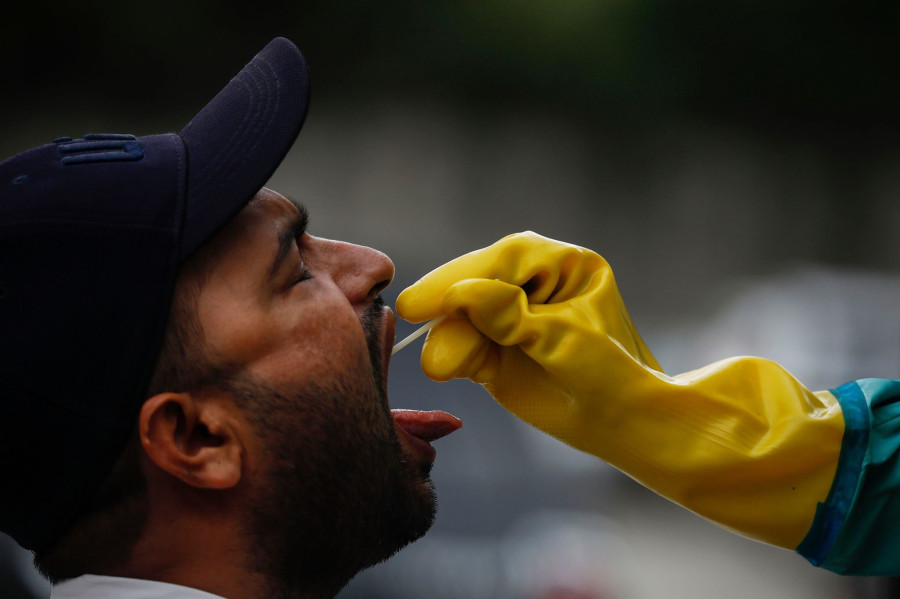Valley
As Covid-19 cases rise, Kathmandu Valley could see yet another lockdown
Restrictions can’t be ruled out amid increasing risk of virus spread and difficulty in contact tracing, officials say.
Arjun Poudel
Health officials have recommended another lockdown in Kathmandu Valley, as the risk of coronavirus spread has risen several fold since the end of nation-wide lockdown on July 21.
Thousands of people have been entering the Valley every day from across the country as well as from India, and the number of people testing positive among them is growing.
“We cannot rule out another lockdown in the Valley if the number of cases keeps rising at the current rate,” an official at the Covid-19 Crisis Management Center told the Post.
Officials at the Epidemiology and Disease Control Division have also recommended that the Health Ministry impose another lockdown in the Valley. “The infection rate in the Valley will go out of control if restrictions are not reimposed,” said an official of the Division on condition of anonymity because he was not authorised to talk to the media.
Officials are especially worried about the difficulty in contact tracing. “We don’t know how many people they met and which public vehicles they boarded,” Dr Basudev Pandey, director at the Division, told the Post.
The Division has been unable to trace the contact of several infected people, including the mayor of Birgunj Metropolitan City who is receiving treatment in Kathmandu. “Since his report came positive, he has stopped responding to our phone calls,” said an official at the Division. “We are still unable to trace his contacts.”
The Division has reported the situation in the Valley to the Health Ministry. “Now it is up to them whether or not to recommend new restrictions,” said Pandey.
Lockdowns have already been reimposed in Biratnagar, Birgunj, Rajbiraj and several other cities in districts bordering India after new cases grew at a rapid rate there since the lifting of the lockdown. On Saturday the Covid-19 management body directed the local administration of Kailali district to impose a lockdown in Dhangadhi immediately.
Public health experts have warned that Kathmandu Valley could be a new hotspot for the coronavirus, as it is densely populated, crowds are growing in public places and public movement is not regulated.
Moreover, the number of people entering from hard-hit areas is growing every day.
In 24 hours from 3 pm Friday to 3 pm Saturday, over 7,500 people entered Kathmandu Valley using emergency vehicles, food trucks, fruits and vegetable trucks and taking special passes from the local administration, according to the Crisis Management Center.
“Most of the new infections are found among the people coming from the Tarai,” the official said. “Of the 70 persons who tested positive in the Valley on Thursday, 65 were recent arrivals.”
Forty-eight of those tested positive on Thursday were from Kathmandu, Lalitpur and Bhaktapur, according to Uttam Koirala, a senior public health officer at the Epidemiology and Disease Control Division.
Dr Samir Adhikari, joint-spokesperson for the Health Ministry, said there must be strict restrictions on people from entering Kathmandu Valley.
A surveillance study, based on the swabs of 10,000 people who entered the Valley last week, by the Health Ministry showed that 0.7 percent of the people coming into the Valley are infected with the coronavirus.
“All samples are yet to be tested but 0.7 percent of the samples tested so far have come positive, which is alarming,” Dr Adhikari told the Post. “This rate of infection could rise after the results of all the samples.”
As of Saturday, 572 people have tested positive in Kathmandu Valley, 199 of them since the lockdown was lifted, according to the Health Ministry.
The Health Ministry said that 315 new positive cases were found across the country on Saturday, taking the total tally to 20,086. There have been 56 deaths so far.
Authorities have been allowing people coming from the disease-hit areas to go directly to their homes in the Valley.
“Even people who are later found to have tested positive are allowed to go home, as test results only come after five days,” said the Division official.
Maintaining quarantine centres is the responsibility of local units but there are no quarantine centres in Kathmandu Metropolitan City, according to Bidya Sundar Shakya, the mayor.
“It generally takes three weeks to know how much the disease has spread in society after the end of lockdown,” Dr Sher Bahadur Pun, chief of the Clinical Research Unit at Sukraraj Tropical and Infectious Disease Hospital in Teku, said.
“The situation might become more alarming than what is anticipated by the Health Ministry officials now. Detection of 0.7 percent positive cases in the random sampling of people entering the Valley is a serious thing.”
The Health Ministry has also recommended reimposing the odd-even rule for public as well as private vehicles.
Even before the lockdown was ended on July 21, the government had allowed the movement of private vehicles under the odd-even rule.
Meanwhile, the Home Ministry has prohibited people from entering the Valley in the night time (7 pm to 7 am) from July 30.
Umakanta Adhikari, joint-spokesperson for the Ministry of Home Affairs, said a decision on next moves to contain the spread of the virus will be taken soon.
“We will take appropriate decisions from a high-level meeting after assessing the risk,” Adhikari told the Post.
This article has been updated for clarity in 13th para.




 21.12°C Kathmandu
21.12°C Kathmandu










